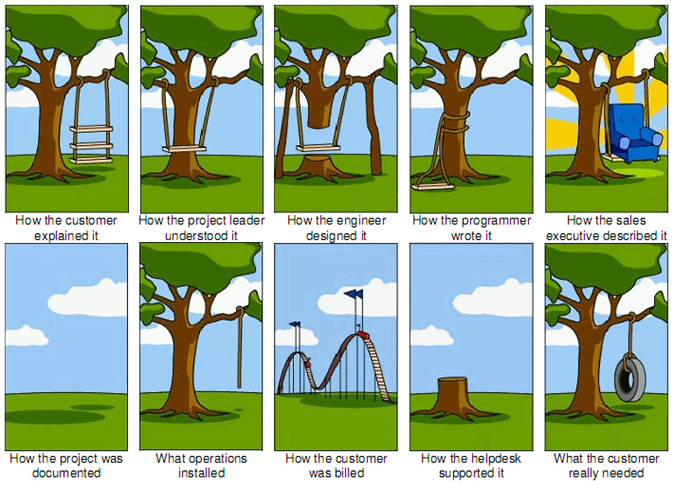Expectations Engineering - how to get there with Whitebox Expectations
If you understand this classic joke, you get the point!

Whitebox Expectations is about to spoil this great joke. We are very sorry, but it’s for all the best reasons.
What is Whitebox Expectations?
Whitebox Expectations is Whitebox’s promise to strengthen the weakest link in the value chain from idea to delivery.
Based on the experienced problems expressed during interviews in 700+ maturity assessments and the following recommended improvements, we found that the industry need a new way of developing and managing the input to “technical engineering”.
We name the concept Expectation Engineering (EE).
The "Why"
EE is meta training, because it starts with establishing “why” a practice is important instead of recommending one practice, EE recognizes the many great practices that are used. EE enable the organization (as well as individuals) to choose the most beneficial practice.
Collaboration
EE is a corporate competence because it is all about collaboration between all stakeholders (including the development team) which require a common language and equal competences.
Collaboration
Holistic
EE is a holistic paradigm, because it reframes several strongly linked disciplines like Requirements Engineering, Risk Management, Configuration Management, Quality and the Testing disciplines to all the stakeholder’s expectations (needs and requirements) to the solution.
Whitebox Expectations constitutes an ambitious learning system designed to implement EE, which easily can be configured in relation to roles, problems, scope, and context.
Learnings leading to Whitebox Expectations
In our 30 years of experience, we have seen:
– That different roles need different competences. Thats why Whitebox Expectations is role based competence development
– No one size fits all! That’s why Whitebox Expectations is driven by the benefit you will achieve and then enabling you to make the best choice of methods and practices
– When information is spread around, it is not used! That’s why Whitebox Expectations introduce a corporate memory
– A common framework for understanding is required! That’s why Whitebox Expectations is a holistic approach across classic disciplines with a strict defined terminology
– Splitting up the responsibilities in requirements, risk and test destroys the “flow”! That’s why Whitebox Expectations support the “flow” (from e.g. a need is expressed and until it is validated that the solutions is supporting it)
– The Product Owner have to be superman! That’s why Whitebox Expectations is a corporate competence
Why did the industry fail to manage all the requirements for decades?
That was also the Whitebox initial question. We had to be sure to know before we could make a different solution.
Short answer: Underestimated complexity!
Communicating needs and requirements are surprisingly difficult – even between the stakeholders.
Everyone feel that their perspective is obvious.
No-one feels really understood.
Root cause: Misunderstandings, small but many.
Add to this:
- There are many stakeholders
- They have very different background
- They have different motivations
- The key stakeholders are those that are the least “accessible“
- New Technology opportunities appears fast
- Sometimes faster than a project can react to them
- Tools to support the communication have been very poor
Suddenly it seems reasonably to believe that poor communication on a very complex matter is constantly leading to misunderstandings that jeopardize development projects.
Failed strategies to solve the cause: Individual training in isolated disciplines.
The last 3 decades we have seen a lot of effort going to test/risk/requirements training to individuals, but it has hardly improved the industry’s performance. The market for these individual trainings is declining for good reasons, – because it is ultimately a teams game. The sports analogy is appropriate. Even the best trained individuals cannot make up for a poor team performance and if they on top of it all are to narrow specialized, no one should expect a high performing team.
“Whitebox Expectations” is covering the three steps to corporate competence
1: Training of all the basic competences required to individuals
2: Leadership training for middle management
3: Establishing support from the entire organization
Whitebox Expectations is a holistic approach to requirements engineering, testing, risk management and configuration management, called Expectations Engineering. Holistic, because the synergy that occurs when they are performed as one coherent discipline are so much bigger than when performed as individual disciplines.
Expectations Engineering is how we should respect the complexity, handle it, avoid the misunderstandings. With teams that are trained expectations engineers you can ambitiously go for the business opportunities, and expect reliable results. Better products, faster.